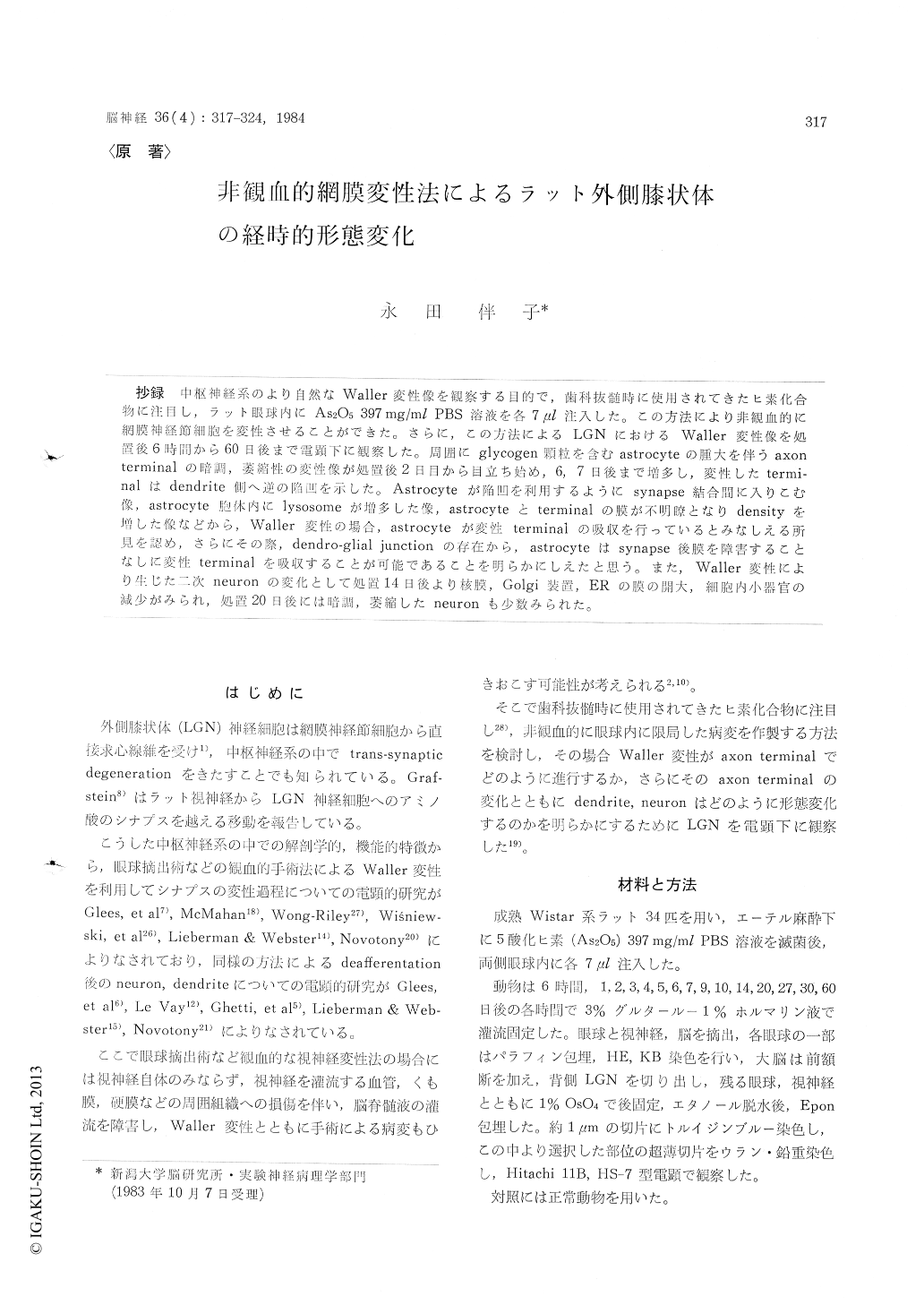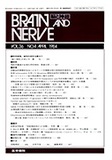Japanese
English
- 有料閲覧
- Abstract 文献概要
- 1ページ目 Look Inside
抄録 中枢神経系のより自然なWaller変性像を観察す目的で,歯科抜髄時に使用されてきたヒ素化合物に注目し,ラット眼球内にAs2O5397 mg/ml PBS溶液を各7μl注入した。この方法により非観血的に網膜経節細胞を変性させることができた。さらに,この方法によるLGNにおけるWaller変性像を処置後6時間から60日後まで電顕下に観察した周囲にglycogen顆粒を含むastrocyteの腫大を伴うaxonterminalの暗調,萎縮性の変性像が処置後2日目から目立ち始め,6,7日後まで増多し,変性したtermi—nalはdendrite側へ逆の陥凹を示した。Astrocyteが陥凹を不利用するようにsynapse結合間に入りこむ像,astrocyte胞体内に1ysosomeが増多した像,astrocyteとtermina1の膜が不明瞭となりdensityを増した像などから,Waller変性の場合,astrocyteが変性terminalの吸収を行っているとみなしえる所見を認め,さらにその際,dendro-glial junctionの存在から,astrocyteはsynapse後膜を障害することなしに変性terminalを吸収することが可能であることを明らかにしえたと思う。また,Waller変性により生じた二次neuronの変化として処置14日後より核膜,Golgi装置,ERの膜の開大,細胞内小器官の減少がみられ,処置20日後には暗調,萎縮したneuronも少数みられた。
By intravitreal injection of arsenous pentoxide (As2O5), which had been used in the pulpectomy in the dentistry, the retina, including the ganglion cell layer, fell selectively into necrosis and the lesions were uniform throughout all part of the retina. Following these non-surgically induced re-tinal lesions, the dorsal lateral geniculate nucleusof the rats was examined by electron microscope over varying periods of time.
From 2 days after the injection, dark atrophic axon terminals appeared in the dorsal lateral ge-niculate nucleus and these terminals were in most instances surrounded by swollen astrocytic proces-ses with glycogen particles. The quantity of the degenerating terminals maximized at 6 to 7 days after injection and then decreased by 60 days.
It was also shown that various features of the degenerating terminals were related to the post-synaptic dendrites. In early stages these degene-rating axon terminals had dense, swollen mito-chondria and many synaptic vesicles in the electron dense matrix. Then these terminals were deeply indented to the apposed dendrites and by this indentation the astrocytic process seemed to insi-nuate into the synaptic junction. In these situa-tions, the cytoplasm of astrocytes increased in electron density around the terminals. The post-synaptic density and the subsynaptic organellas were clearly shown to be identical through the course of the degeneration. There were also dendro-astroglial junctions, and these junctions seemed to be one of the features of degeneration of the terminals. It was suggested that there was an obvious course of the degenerating terminals separated from their post-synaptic sites without disruption of integrity of the post-synaptic memb-rane specialization by astrocytic cell process in Wallerian degeneration.
In the dendrites, some showed edematous swell-ing with vacuoles delimited by unit membrane, and some showed increased density of filamentous structures, which accentuated in a portion of the degenerating terminals with indentation into the dendrite. In the neuronal soma, dilatation of the nuclear membrane, ER, and Golgi apparatus, nuc-lear infoldings, overall reduction of the cell orga-nellas with swollen astrocytes were seen 14 days after the injection. These changes seemed confined to rather small neurons. Other charactritics of increased tubular structures were also seen. At 20th days, a few dark neurons were seen. Neuronal cell loss was not detected by 60 days. These chan-ges of the dendrites and neurons seemed in accord-ance with the quantity of the terminal degene-rations.
These ultrastructural alterations of axon ter-minals, dendrites, neurons, as well as glial reac-tions were thought to be the non-surgically indu-ced Wallerian degeneration and its influence on the secondary neurons and this will offer indica-tions on considering the pathomechanism of the human degenerative diseases of unknown etiology.

Copyright © 1984, Igaku-Shoin Ltd. All rights reserved.


